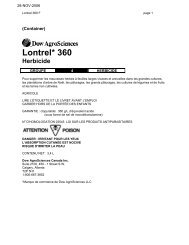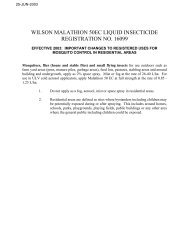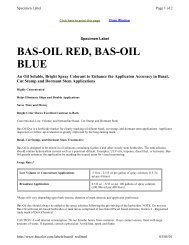Garlon 4 Brush Management - TrueNorth Specialty Products
Garlon 4 Brush Management - TrueNorth Specialty Products
Garlon 4 Brush Management - TrueNorth Specialty Products
You also want an ePaper? Increase the reach of your titles
YUMPU automatically turns print PDFs into web optimized ePapers that Google loves.
<strong>Brush</strong> <strong>Management</strong> with<br />
<strong>Garlon</strong>* 4<br />
Application guidelines<br />
Active ingredient: triclopyr ester<br />
Control description: <strong>Garlon</strong> 4 is readily absorbed<br />
by the foliage of growing plants and translocates to<br />
the growth regions of the plant (meristems). It creates<br />
an imbalance of plant growth hormones, causing<br />
unregulated growth which kills the plant.<br />
For consistent brush control, apply <strong>Garlon</strong> (foliar)<br />
after full-leaf development and before autumn<br />
colouration. Adequate soil moisture for normal plant<br />
growth is important for consistent control. Balsam poplar<br />
and willow can yellow due to drought stress in July,<br />
reducing efficacy. An indicator of potential loss of<br />
efficacy is hardening leaves that lose their elasticity when<br />
gently crushed in the hand.<br />
Rate. Apply <strong>Garlon</strong> at a rate of 4 to 8 litres per hectare.<br />
Use higher application rates as seasonal growth slows or<br />
when hard-to-kill species are present.<br />
Coverage. Mix <strong>Garlon</strong> in at least 400 litres of water per<br />
hectare, up to 1,000 litres of water per hectare (35 to 90<br />
imperial gallons per acre). Ensure even or uniform<br />
coverage of target plants.<br />
For more detailed information on coverage refer to the<br />
“Guide to Improving Triclopyr Ester Efficacy”.<br />
Drift management. When using large droplets to<br />
reduce risk of drift, increase spray volume<br />
to maintain uniformity of coverage.<br />
HARD-TO-KILL SPECIES<br />
Maples are the main hard-to-kill species, but aspen<br />
and balsam poplar can be problematic to control near<br />
the end of the season.When treating these species or<br />
spraying late in the growing season, pay particular<br />
attention to coverage and condition of foliage on<br />
target plants to ensure adequate control.<br />
FACTORS AFFECTING PERFORMANCE<br />
Dr. Bob Campbell (Herbicide Physiologist, Forest Pest<br />
<strong>Management</strong> Institute, Great Lakes Forestry Center)<br />
evaluated the impact of herbicide concentration,<br />
droplet size and droplet number of triclopyr on the<br />
control of aspen.<br />
Campbell’s experiments indicated that coverage is the<br />
most important variable when applying triclopyr foliar.<br />
The key to successfully applying foliar triclopyr is even<br />
or uniform coverage with no shadows or scattered,<br />
large, splotchy droplets on target plants.<br />
PERFORMANCE EXPECTATIONS<br />
When evaluating <strong>Garlon</strong> applications it is important to<br />
have realistic expectations in mind. Research trials<br />
have evaluated the following two criteria for control<br />
performance:<br />
1. Percentage defoliation: percentage of the foliage<br />
on the vegetation that is gone and/or discoloured.<br />
2. Stem kill: percentage of each stem that is dead.<br />
When planning an application of <strong>Garlon</strong>, be sure to<br />
choose rates, equipment and methods appropriate for<br />
the level of control (percentage defoliation and stem<br />
kill) you require.<br />
Re-growth can be expected with certain species.<br />
Extent of re-growth depends on seasonal timing,<br />
coverage, application rate, and species treated, in that<br />
order.
General guidelines for brush control<br />
The success of a vegetation management program can be<br />
greatly influenced by what type of application equipment<br />
and method are employed. Factors that influence optimal<br />
control include atomizer orifice size, spray pressure,<br />
atomizer stability, atomizer dwell time over target and<br />
atomizer orientation. For all equipment and methods<br />
used, these factors should be adjusted to ensure even<br />
coverage of target vegetation and sufficient penetration of<br />
target plant canopies to ensure at least 70% of the height<br />
of target plant crowns are covered.<br />
EQUIPMENT<br />
Hose and hand gun. Perhaps the oldest and most<br />
commonly used application method for both spot and<br />
broadcast treatment of brush is the hose and hand gun.<br />
Many different models are available, most with the ability to<br />
adjust the spray pattern from a solid stream to a wide cone<br />
pattern. Droplet size is variable, determined by pump<br />
pressure, size of orifice and spray pattern setting.Typically,<br />
pressures of 100 to 300 psi and spray volumes of 800 to<br />
2,000 litres per hectare are required to adequately wet brush<br />
to the point of runoff.<br />
When using handguns to apply <strong>Garlon</strong>, pay particular<br />
attention to nozzle orientation and dwell time, as these<br />
factors are vital to maintaining adequate coverage and<br />
canopy penetration. Increased application pressure will<br />
not replace proper downward-directed application with<br />
sufficient dwell time.<br />
Boomless spray equipment. In recent years, broadcast<br />
spraying using boomless spray equipment has become<br />
increasingly popular. Some of the commercially available<br />
equipment include the off centre nozzle (OC).This is a<br />
single nozzle that produces a wide swath, flat spray pattern.<br />
Although it operates at low pressures (30 to 40 psi), drift<br />
is a concern because of the wide range of droplet sizes it<br />
produces.Tests show that droplets closest to the nozzle<br />
centre are small, while the droplets on the outer edge are<br />
coarse, leading to irregularities in coverage.<br />
What else do you need?<br />
For even more information on how Dow AgroSciences can meet your<br />
vegetation management needs, call the Solutions Center at 1-800-667-3852,<br />
or visit us at www.dowagro.ca.<br />
The Boom Buster ® nozzle is a straight stream, diffuse nozzle<br />
available in different spray widths and outputs. The stream<br />
of spray solution is split by a plastic vane to produce a fan<br />
pattern. Proper operating pressure is between 30 and 50 psi.<br />
As with the OC nozzle, it is important to ensure that the<br />
spray pattern covers the top of the brush canopy. But at<br />
higher spray heights, be aware that air movement can often<br />
distort the spray pattern and thus lessen coverage.<br />
Both OC and Boom Buster nozzles produce somewhat<br />
uneven patterns and droplet sizes.This makes them difficult<br />
to calibrate to achieve adequate coverage and renders them<br />
more susceptible to drift. Use these nozzles only for narrow<br />
band control of weeds or for brush less than 1.5 m in height.<br />
Radiarc. Another popular boomless device is the radiarc<br />
controlled droplet applicator, which consists of two parallel<br />
rows of up to 11 straight-stream nozzles that oscillate to<br />
break up the stream of spray solution. Five nozzle sizes are<br />
available with the larger .070, .085 and .101 nozzles most<br />
practical for brush spraying. The spray head can be mounted<br />
to spray either a horizontal or vertical pattern. Uniform<br />
droplet size provides a high degree of drift control.<br />
METHODS<br />
With the boomless spray nozzles (atomizers), it is not<br />
necessary to use the higher hand gun water volume rates of<br />
application. However, water volumes must be sufficient to<br />
provide thorough coverage and foliar canopy penetration.<br />
For medium density brush, water volumes of 200 to 400<br />
litres per hectare are generally used. The key to successfully<br />
applying foliar triclopyr is even or uniform coverage with no<br />
shadows or scattered, large, splotchy droplets on target plants.<br />
Water volume becomes a significant factor only when<br />
droplet size is increased to address other concerns, such as<br />
drift control. In such cases, increase water volume to ensure<br />
uniform coverage. This is particularly important when<br />
treating larger or taller brush with broadcast application.<br />
This is not a label, and is intended as a<br />
review of key guidelines for use of this product.<br />
Before using <strong>Garlon</strong> 4, read and follow label<br />
directions.<br />
*Trademark of Dow AgroSciences LLC<br />
® All other products are registered trademarks of their<br />
respective companies.<br />
0204-485-079


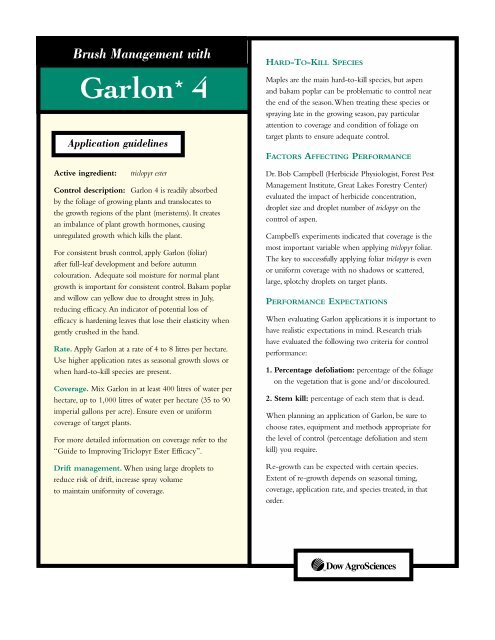

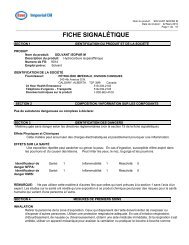
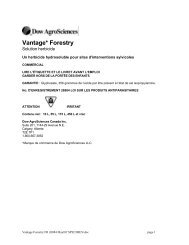
![Princep NineT [pamphlet] - True North Specialty Products](https://img.yumpu.com/17323153/1/190x245/princep-ninet-pamphlet-true-north-specialty-products.jpg?quality=85)
